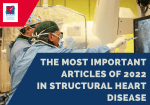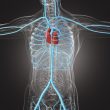Percutaneous coronary intervention (PCI) to the left main coronary artery (LMCA) with drug-eluting stent implantation is currently a major challenge due to the size of the vessel, the compromise of a bifurcation lesion in important branches, and the potential risk of complications. Available information on LMCA PCI comes from studies where DES stents were implanted...
The Most Important Articles of 2022 in Structural Heart Disease
Discover the most read scientific articles on interventional cardiology of 2022 in our website. We Should Treat Significant Stable CAD in Patients Undergoing TAVR Aortic stenosis is associated to significant coronary artery disease (CAD) in nearly 50% of cases. When we decide to treat aortic disease using surgery, it has been established we should also treat...
Hybrid Coronary Revascularization: A Valid Option?
In this article, we will examine the use of hybrid coronary revascularization to treat multivessel coronary artery disease. Coronary artery disease (CAD) is the most common cause of morbidity and mortality in the western world. The presence of multivessel CAD is associated to high short and midterm mortality and coronary artery bypass graft (CABG) is...
Real-World Revascularization Strategy for Left Main Coronary Artery: Surgery or PCI?
There are many current randomized trials comparing percutaneous coronary intervention (PCI) with myocardial revascularization surgery (MRS) for the treatment of left main coronary artery disease (LMCAD). In the European Society of Cardiology guidelines, PCI is classified as Ia (LMCAD with low-complexity coronary disease) or IIa indication (intermediate complexity), whereas, according to the American Heart Association...
IVUS Use in Peripheral Vascular Disease: Should this Tool Be Used More Frequently in Peripheral Interventions?
Use of intravascular ultrasound (IVUS) has increased rapidly, and several randomized and observational studies have shown improved results in patients who underwent coronary angioplasty using this tool. However, evidence on IVUS on peripheral interventions is more limited. Observational studies have found similar benefits when IVUS was part of the revascularization strategy. In a meta-analysis of...
Safety of Atherectomy in Femoropopliteal Disease
Peripheral artery disease hinders patient quality of life extensively. In advanced stages, such as critical lower limbs ischemia (CLLI), it could yield an increased risk in major cardiovascular events, as well as limb-related events (amputation or repeat revascularization), making treatment with revascularization paramount in these cases. Calcification is a predictor of revascularization failure, which is...
Long-Term Mortality in Non-Obstructive Lesions in the Left Main Coronary Artery
Left main coronary artery (LMCA) intervention with significant lesions on both coronary angiography and intravascular ultrasound (IVUS), either through angioplasty (PCI) or myocardial revascularization surgery (MRS), is directly related to a decrease in long-term adverse clinical events. However, the relationship between subclinical LMCA disease (preserved luminal diameters) and long-term mortality is still unknown. A retrospective...
Coronary Artery Dissection and Cardiogenic Shock: How Do They Evolve?
Spontaneous coronary artery dissections (SCD) are more frequent in women and account for about 25% of all acute myocardial infarctions (AMI) before the age of 50. While the presence of cardiogenic shock due to AMI is infrequent, its evolution is still somewhat unclear and it has not been fully analyzed. Researchers conducted an analysis in...
Early invasive Strategy for Non-ST Elevation ACS in Chronic Kidney Disease
Many randomized studies and systematic revisions have shown that an early invasive approach (within 24hrs. after diagnosis) will not reduce mortality across the non-ST elevation acute coronary syndrome (NST-ACS) population, hence the relevance of NST-ACS; patients with a GRACE score higher than 140 were the ones showing improved outcomes. Roughly 40% of NST-ACS patients have...
Spontaneous Coronary Artery Dissection: Treatment and Prognosis
Spontaneous coronary artery dissection (SCAD) is a non-traumatic nor iatrogenic event that causes a separation of the coronary artery tissue due to an intimal tear or a mural spontaneous hemorrhage. This event is most frequent in young females and usually causes an acute myocardial infarction that could be major. It accounts for 1% to 4%...









